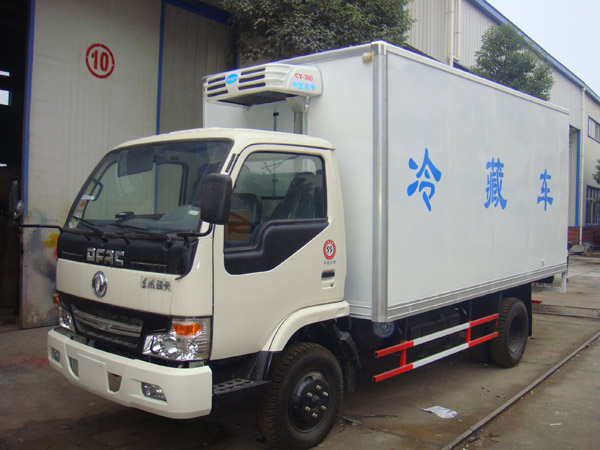Now, with the increasing variety of goods stored and transported, some goods are susceptible to deterioration and deterioration due to external temperature, humidity and other conditions during storage and transportation. In order to maintain the original quality and value of perishable goods, refrigerated and insulated cars have become an indispensable transportation tool in human life. A refrigerated vehicle is a closed-type van specially designed for transporting frozen or preserved goods. It is a refrigerated special-purpose transportation vehicle equipped with a refrigerating unit of a refrigeration unit and a polyurethane insulated cabin, and is commonly used for transporting frozen foods (refrigerated vehicles). Dairy products (milk transport vehicles), fruits and vegetables (fresh goods transport vehicles), vaccine drugs (vaccine transport vehicles), etc. First, the classification of refrigerated car The refrigerated car is actually called refrigerated car, it is divided into two categories of refrigerated car and insulated car. Insulation cars are cars with insulated cars that are suitable for short-distance heat preservation and transportation. A refrigerated car is a car that has an insulated car and is equipped with a refrigeration device. Refrigerated vehicles are classified into mechanical refrigerated vehicles, frozen-plate refrigerated vehicles, liquid nitrogen refrigerated vehicles, and dry-ice refrigerated vehicles according to the refrigerating devices.
According to the refrigeration method of refrigeration equipment, mechanical refrigerated vehicles, frozen-plate refrigerated vehicles, liquid nitrogen refrigerated vehicles, dry ice refrigerated vehicles, ice-cold refrigerated vehicles, among which mechanical refrigerated vehicles are the main models of refrigerated vehicles. The refrigerated truck is composed of the walking part of the chassis of the special vehicle, the heat insulation and insulation body (usually composed of polyurethane material, glass fiber reinforced plastic, color steel plate, stainless steel, etc.), the refrigeration unit, and the temperature recorder in the compartment, etc. For vehicles with special requirements, Such as meat hook car, can be installed meat hook, waist, aluminum alloy rails, ventilation slots and other optional parts.

The most widely used is the mechanical refrigerated vehicle. It is equipped with a vapor-compression refrigeration unit, and the interior temperature is automatically controlled. It is suitable for the transportation of short, medium, long-distance or special refrigerated cargo. The car has good heat insulation, reduces the temperature inside the outside car, and the refrigeration device occupies less space, is light in weight, safe and reliable, and is not easy to fail. The arrangement is mainly determined based on the structure of the refrigeration unit (positions of the drive, compressor, condenser, evaporator). The following is an example of a mechanically refrigerated vehicle, analyzing its structure. According to the driving method, the refrigeration unit can be divided into independent and non-independent. The independent refrigeration unit itself has a drive device, and the non-freezing refrigeration unit is driven by the main engine of the automobile. According to the position of the four components of the drive device, compressor, condenser and evaporator, the refrigeration unit can be divided into integral type and split type. The four components are called the integrated unit in the carriage; the four components are installed in different locations, and the connected units are separated.
The layout of cold-plate refrigerated vehicles depends on the form of cold-plate refrigerating devices, which are divided into two types: independent and non-independent; the layout of liquid-nitrogen refrigerated vehicles is very much dependent on the size and position of liquid nitrogen tubes, such as liquid nitrogen tanks. Vertical inside the cabin, horizontal inside the cabin, outside the cabin, outside the compartment and so on.
The insulation container of the refrigerated and insulated vehicle is a sealed cabinet with a certain insulation performance, which is composed of the container insulation wall, doors and cargo box accessories. There are two types of insulation containers: monolithic and split-type. The requirements for thermal insulation materials are: 1. Uniform foaming, low density; 2. Low thermal conductivity as possible. The general requirement is 0.045 W/(m). • k); 3, the stability to temperature changes is better, in the use temperature range of -40 ~ 70 °C, the use of performance to meet the required requirements; 4, has a certain degree of mechanical strength, can withstand the car in harsh road conditions Vibration, impact without damage or deformation; 5, low water absorption and moisture absorption, corrosion resistance, good frost resistance; 6, non-toxic and tasteless, low permeability, thermal insulation material can not be decomposed toxic when used and burned And harmful gases; 7, low price, easy to form, can be filled, cast, spray and other processes to form the car insulation. The most popular insulation materials now used are polystyrene foam and polyurethane foam.
The design of the thermal break bridge eliminates the direct connection of the metal parts between the skins of the thermal insulation container, and the skin of the thermal insulation container is connected with the skeleton. The skeleton is divided into a main skeleton with a bearing function and an auxiliary skeleton with a thermal insulation function. In addition, the insulation box of the refrigerated and insulated vehicle also includes door frame and door accessories, sealing strips, air guide strips and special-shaped flooring, hooks and hanging rails, and evaporator protection frames. The process flow of carriage processing is roughly as follows: Component production → each piece of metal skeleton assembly → riveted outer skin → installation of auxiliary skeleton → installation of inner skin → injection of foam material → installation of rear door assembly.
Bumper washer, spool, end washer, axle, bearing housing, snap ring, bushing, bearing, hub, sprocket, wear shin, idler, wear plate, etc.
Kmc replacement Parts, Kelly Replacement Parts, Kmc/kelly Replacement spare Parts, KMC/Kelly agricultural machinery replacement parts
NingBo Greenly Machinery Co.,LTD , https://www.greenlyagparts.com